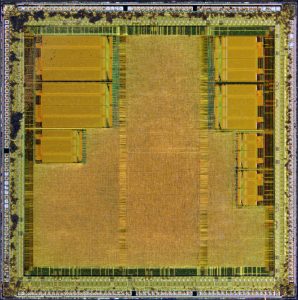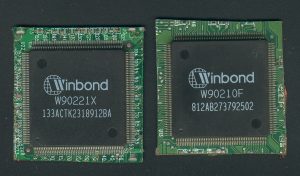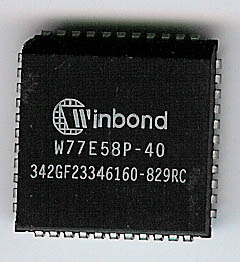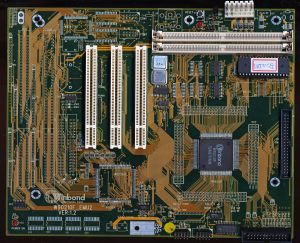The Forgotten Ones: RISCy Business of Winbond
Winbond Electronics was founded in Taiwan back in 1987, and is most widely known for their memory products and system I/O controllers (found on many motherboards of the 1990s). They also made a wide variety of microcontrollers, mostly based on the Intel MCS-51 core, like many many other companies have and continue to do. They also made a few 8042 based controllers, typically used as keyboard controllers, and often integrated into their Super I/O chips. So why do I find myself writing about Winbond, whose product portfolio seems admittedly boring?
It turns out, that once upon a time, Winbond decided to take a journey on a rather ambition path. Back in the early 1990’s they began work on a 32-bit RISC processor, and not an ARM or MIPS processor that were just starting to become known at the time, but a processor based on the HP PA-RISC architecture. This may seem a odd, but HP, in a shift form their previous architectures, wanted the PA-RISC design to be available to others. The Precision RISC Organization was formed to market and develop designs using the architecture outside of HP. HP wanted to move all of their non-x86 systems to a single RISC architecture, and to help it become popular, and well supported, it was to be licensed to others. This is one of the same reasons that made x86 so dominate in the PC universe. More platforms running PA-RISC, even of they were not HP, meant more developers writing PA-RISC code, and that mean more software, more support, and a wider user base. Along with Winbond, Hitachi and OKI also developed PA-RISC controllers. Winbond’s path was innovative and much different then others, they saw the need for easy development as crucial to their products success, so when they designed their first PA-RISC processor, the W89K, they made it a bit special.
In 1994, most everyone had a Intel 486 based computer, so Winbond decided to make the W89K 486DX compatible, electrically and logically, this allowed many existing boards to be used as development systems. Replace the 486DX processor with he W89K and replace the BIOS with a Winbond one, and instant development system. The system hardware (RAM, PCI slots, etc are agnostic about what CPU is talking to them, so this is easier then it sounds, and much more so back in the 1990’s then today.
The W89K was made on a 0.8u double metal CMOS process and ran at up to 66MHz (clock doubled version using the standard 33MHz 486 bus) with 1.1 million transistors . It implemented PA-RISC V1.1 with a 5-stage pipeline and 2K each of instruction and data caches, both fully associative. It was designed with only the integer unit (no FPU) as a way to reduce die size and cost. This was considered acceptable as it was targeted as a high end embedded controller (for use in things like printers). They did support a L2 external cache as well, something that was unusual for the PA-RISC. Performance was around 89 DMIPS (Dhrystone MIPS for the 66MHz part.

Winbond W90210F 66MHz PA-RISC 0.8u CMOS – 4K instruction cache is in the upper left, while the smaller 2K Data cache is in the upper right (die shot by aberco)
The successor to the W89K was the W90K family which was developed in 1997. The first processor of this family was the W90210F. It originally was going to be still called the W89K family but Winbond decided in late 1987 to called it the W90K, due to its greatly improved design compared to the W89K. The 90K maintained the same PA-RISC core as before but added a host of peripherals to increases its usefulness as an embedded controller. These included embedded ROM/Flash interfaces, a DRAM controller, a DMA controller and various timers/counters. It also added the 5 PA-RISC multimedia instructions (MAX-1). These were some of the very first SIMD instructions added to general purpose processors (originally designed for the PA7100LC). Intel added similar support to the Pentium as ‘MMX’. The W90210 also changed the cache structure. The L1 Instruction cache continued to be direct mapped but was increased from 2K to 4K. The Data cache remained 2K but was now 2-way set associative. Clock speed remained the same at 66MHz. A W90215F version was also made, that did not come with an embedded OS license (write your own). These were used in a number of printers, set top boxes and digital picture frames back in the late 1990s.

W90221X – 100MHz with hardware MAC and SDRAM support. and built in 2-D Graphics Maintained the same package as the W90210F to simplify designs
In 1991 the last versions were released. These were the W90220 and W90221. These both had some big improvements over the previous design. They were made on a CMOS triple layer 0.35u process allowing clock speeds of up to 150MHz (this appears to be the design goal, actual devices may have topped out at 133MHz in practice). A Multiply Accumulator unit was added allowing for DSP like functionality and the pipeline was increased to 6-stages (a Load/store unit) which helped achieve the faster clock speeds. Both caches were now 4K, with the instruction cache still being direct mapped, and the Data cache being 4-way set associative. It also is the first of the line to support hardware branch prediction. These were 3.3V parts with 5V I/O.
The W90220 added a 2D graphics controller to the system as well as support (finally) for SDRAM. Two versions of the 90220 were made. The W90220F which was to hit 180MHz and support SDRAM and EDO RAM, and the cost reduced W90220X which was limited to 80-100MHz, had less I/O and no EDO RAM support.
By the early 2000’s the W90K PA-RISC processor was dead, its a rather unfortunate end to an ambitious project, and a processor that really had great potential and performance for its time. In researching these processors it seemed that one of the reasons the processor failed was poor support from Winbond. Its ironic that a processor designed for easy development and interfacing with existing PC peripherals would be hindered by poor tech support from the manufacturer but that appears to be the case. Also contributing to its demise was the fall of PA-RISC itself, by 2000 H was ‘all in’ with Intel on PA-RISC’s successor, the IA-64 architecture Itanium processor and we all know how that turned out. It’s perhaps interesting then that laser printers and digital picture frames are powered by a processor that evolved into what was suppose to be the next great Intel architecture, but now, in a twist of fate, is itself a wall hanger




